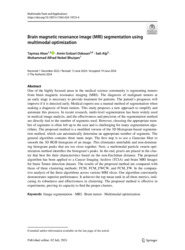Brain magnetic resonance image (MRI) segmentation using multimodal optimization
-
Yazar
Taymaz Akan
-
Tür
Makale
- Yayın Yılı 2024
- Veritabanları Scopus
- DOI 10.1007/s11042-024-19725-4
-
Yayıncı
Springer
- Dergi Multimedia Tools and Applications
- Tek Biçim Adres https://hdl.handle.net/20.500.14081/2154
-
Konu Başlıkları
Brain tumor
Image segmentation
Multimodal optimization
MRI
One of the highly focused areas in the medical science community is segmenting tumors from brain magnetic resonance imaging (MRI). The diagnosis of malignant tumors at an early stage is necessary to provide treatment for patients. The patient’s prognosis will improve if it is detected early. Medical experts use a manual method of segmentation when making a diagnosis of brain tumors. This study proposes a new approach to simplify and automate this process. In recent research, multi-level segmentation has been widely used in medical image analysis, and the effectiveness and precision of the segmentation method are directly tied to the number of segments used. However, choosing the appropriate number of segments is often left up to the user and is challenging for many segmentation algorithms. The proposed method is a modified version of the 3D Histogram-based segmentation method, which can automatically determine an appropriate number of segments. The general algorithm contains three main steps: The first step is to use a Gaussian filter to smooth the 3D RGB histogram of an image. This eliminates unreliable and non-dominating histogram peaks that are too close together. Next, a multimodal particle swarm optimization method identifies the histogram’s peaks. In the end, pixels are placed in the cluster that best fits their characteristics based on the non-Euclidean distance. The proposed algorithm has been applied to a Cancer Imaging Archive (TCIA) and brain MRI Images for brain Tumor detection dataset. The results of the proposed method are compared with those of three clustering methods: FCM, FCM_FWCW, and FCM_FW. In the comparative analysis of the three algorithms across various MRI slices. Our algorithm consistently demonstrates superior performance. It achieves the top mean rank in all three metrics, indicating its robustness and effectiveness in clustering. The proposed method is effective in experiments, proving its capacity to find the proper clusters.
-
Koleksiyonlar
Fakülteler
Mühendislik Fakültesi


 Tam Metin
Tam Metin

